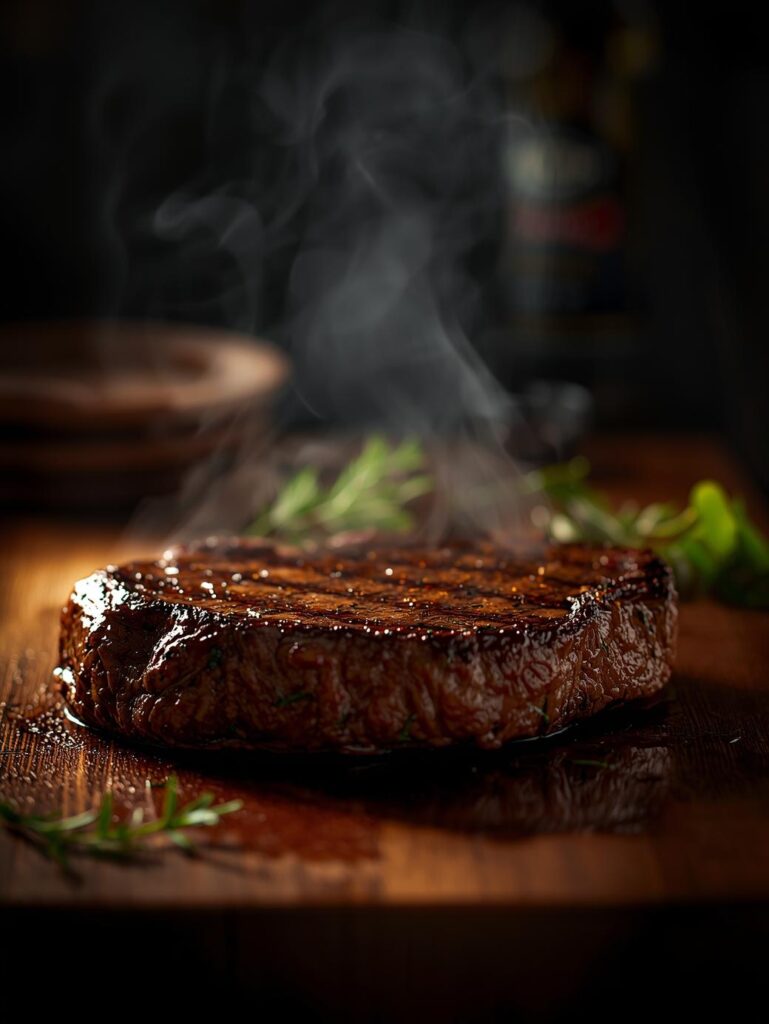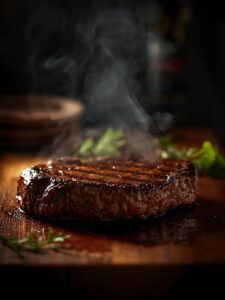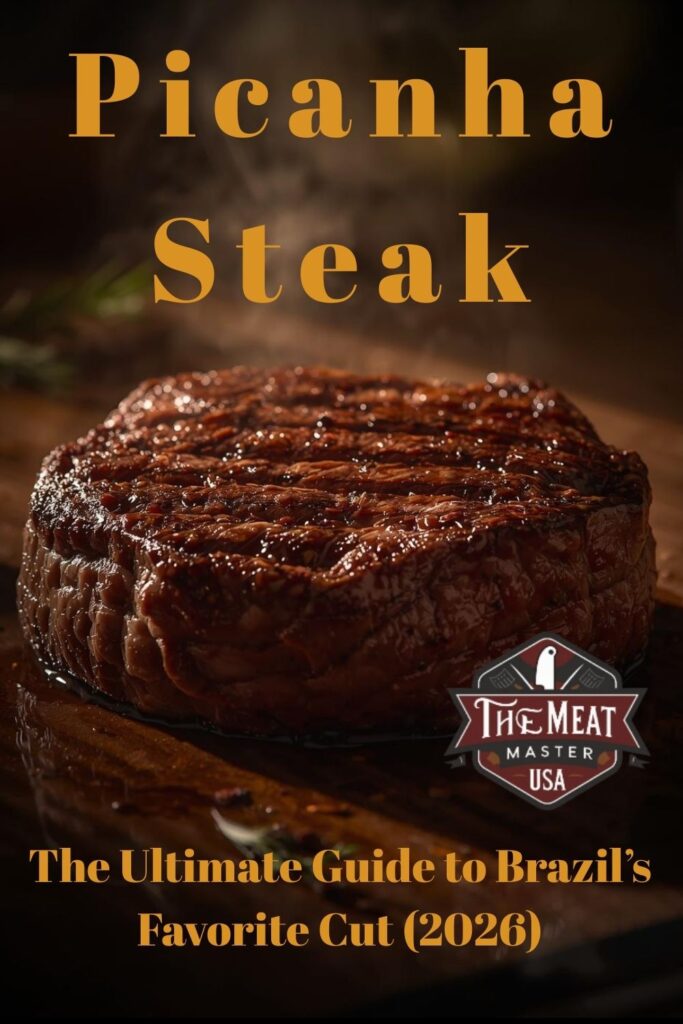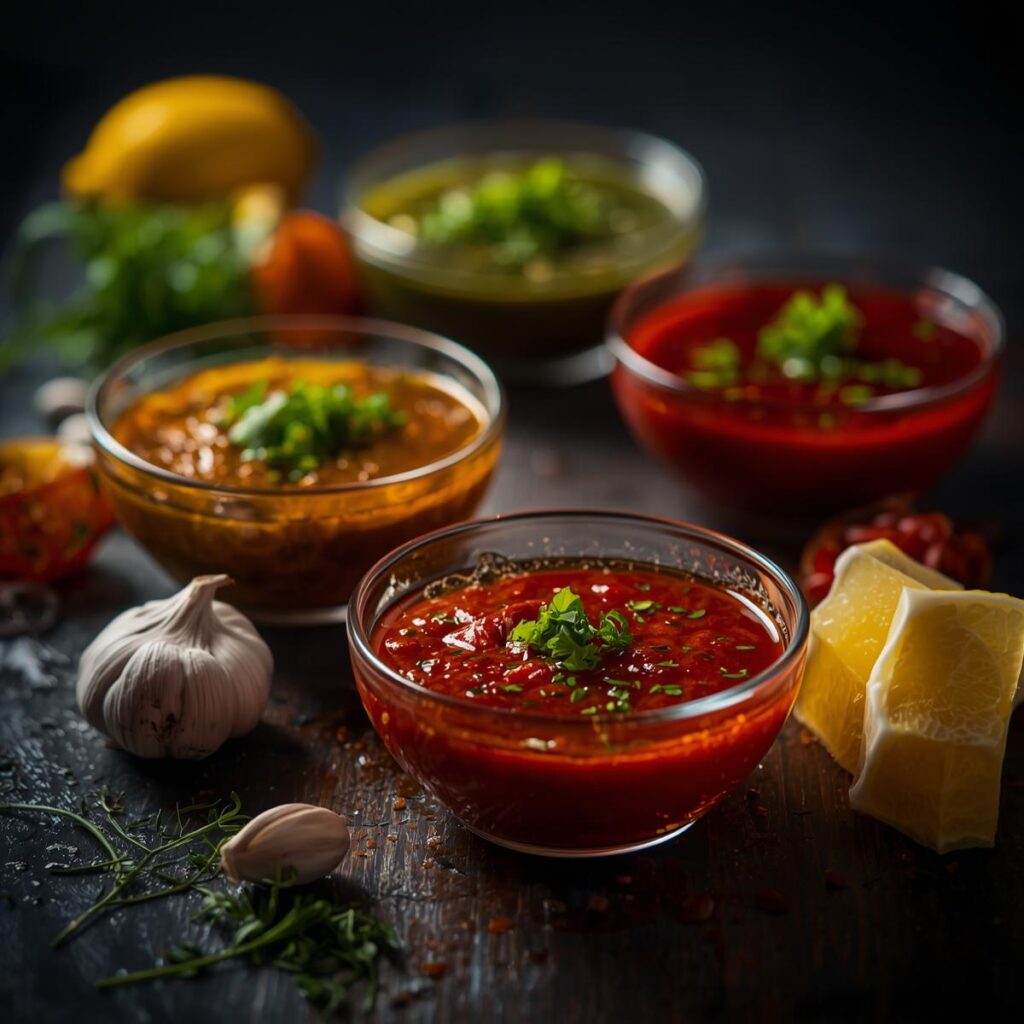Expert’s Note: This guide unlocks the secrets of Brazil’s most beloved cut, featured in our Brazilian Steakhouse Series. Mastering picanha will transform your grilling repertoire and impress everyone who tastes this succulent, garlicky, fat-capped wonder.
BRAZILIAN PICANHA MASTERY: HOW TO COOK THE PERFECT SIRLOIN CAP STEAK
“In Brazil, picanha isn’t just a cut of meat—it’s a cultural icon. The sight of a skilled churrasqueiro slicing thin, crimson strips from a massive skewer of garlic-rubbed, fat-capped beef directly onto your plate is pure theater. But the real magic isn’t the spectacle; it’s the sublime combination of textures: the crackling, salty fat cap, the deeply seasoned crust, and the incredibly tender, beefy interior. This isn’t just cooking; it’s a celebration of fire and fat.”
Brazilian Picanha Mastery: How to Cook the Perfect Sirloin Cap Steak
Download our free Picanha Preparation & Cooking Cheat Sheet with Brazilian techniques.
Picanha (pronounced pee-KAHN-ya) is the crown jewel of Brazilian churrascarias, yet it remains surprisingly overlooked in American backyards. This magnificent cut—the sirloin cap or rump cover—represents the perfect storm of beefy excellence: abundant marbling, a thick fat cap that self-bastes the meat, and a robust flavor that stands up to bold seasoning. This guide will transport the authentic Brazilian steakhouse experience to your grill, teaching you not just how to cook picanha, but how to honor it.
🔍 WHAT IS PICANHA? ANATOMY OF A BRAZILIAN ICON
Understanding where picanha comes from and why it’s so special is the first step to mastering it.
⚙️ The Butcher’s Secret: Location and Structure
Picanha comes from the top of the rump, covering the sirloin primal. It’s a single, triangular-shaped muscle called the *biceps femoris* with two key features:
The Two Marvels of Picanha Anatomy
- The Fat Cap: A thick, uniform layer of fat covering one entire side. When rendered properly, this becomes a crispy, flavorful blanket that bastes the meat throughout cooking.
- The Grain Structure: The muscle fibers run in a single, consistent direction, making it easy to identify and slice against the grain for maximum tenderness.
🎯 Picanha vs. American Cuts: Why It’s Unique
American butchers typically break this area down into other cuts, which is why picanha can be hard to find:
🎯 Picanha vs. Similar American Cuts
| Cut | Key Difference | Flavor Profile |
|---|---|---|
| Picanha | Intact with thick fat cap | Rich, beefy, self-basting |
| Top Sirloin | Fat cap removed, leaner | Beefy but less rich |
| Rump Steak | Different muscle, tougher | Robust but less tender |
| Tri-Tip | Bottom sirloin, different grain | Similar but leaner |
🛒 HOW TO FIND AND SELECT THE PERFECT PICANHA
Sourcing great picanha requires knowing what to ask for and what to look for.
🗣️ Talking to Your Butcher: The Right Terminology
Most American butchers don’t use the term “picanha.” Here’s what to ask for:
- “I’d like the sirloin cap or rump cover with the fat cap left on.”
- “Do you have the coulotte steak?” (French butchery term)
- “I’m looking for the top sirloin with the fat cap intact.”
Better yet, find a Brazilian market or specialty butcher who understands the cut. Many online retailers now carry authentic picanha as well.
👁️ The Visual Checklist for Quality Picanha
✅ IDEAL FAT CAP
Look for ½ to 1-inch thick, creamy white fat cap that covers most of one side. Avoid yellowing fat or thin, patchy coverage.
✅ GOOD MARBLING
Fine, web-like marbling throughout the lean meat. This ensures juiciness and flavor beyond just the fat cap.
✅ TRIANGULAR SHAPE
A relatively uniform triangular shape makes for even cooking and beautiful presentation.
🧂 THE AUTHENTIC BRAZILIAN SEASONING PHILOSOPHY
In Brazil, less is more when it comes to seasoning picanha. The goal is to enhance, not mask, the magnificent beef flavor.
🇧🇷 The Traditional Approach: Coarse Salt & Garlic
Traditional churrascarias use a minimalist approach that lets the meat shine:
Authentic Brazilian Picanha Seasoning
- Coarse Sea Salt: Generously applied to the fat cap and lightly on the meat sides
- Fresh Garlic: Crushed and rubbed over the entire surface (optional but traditional)
- That’s It: No pepper, no herbs, no complicated rubs
Why it works: The coarse salt creates a delicious crust and enhances the natural beef flavor without competing with it.
⚡ The Garlic Infusion Technique
For maximum garlic flavor without burning:
- Crush 4-6 garlic cloves and mix with 2 tablespoons of coarse salt
- Rub this mixture vigorously over the entire picanha, especially the fat cap
- Let it rest for 30-60 minutes before cooking to allow the garlic to penetrate
Pro Tip: The Fat Cap Scoring. Using a sharp knife, score the fat cap in a cross-hatch pattern, cutting about ¼-inch deep. This helps render the fat more effectively and allows the salt and garlic to penetrate deeper into the meat.
🔥 TWO AUTHENTIC COOKING METHODS: SKEWERED OR STEAK CUTS
Picanha can be cooked whole or cut into traditional steaks. Both methods deliver incredible results.
🇧🇷 Method 1: The Authentic Churrasco Skewer
This is how it’s done in Brazilian steakhouses—large, C-shaped cuts roasted over open flames.
Step-by-Step Skewer Method:
- Butterfly and Roll: Cut the picanha with the grain into 2-3 inch thick strips. Roll each strip into a C-shape with the fat cap on the outside.
- Skewer: Insert a large, flat metal skewer through the roll, securing the shape. The fat cap should face outward.
- Season: Apply coarse salt generously to the fat cap.
- Grill: Position skewers around the perimeter of a hot charcoal fire, fat cap facing the heat. Cook until the fat is crispy and internal temperature reaches 120°F for rare/medium-rare.
- Slice and Serve: Hold the skewer upright and slice thin pieces directly onto plates.
🥩 Method 2: Picanha Steaks (The Home Cook’s Approach)
For most home grills, cutting picanha into steaks is more practical and equally delicious.
Step-by-Step Steak Method:
- Slice Against the Grain: Cut the whole picanha into 1.5 to 2-inch thick steaks, cutting against the grain. This creates the characteristic C-shape.
- Season: Apply coarse salt and garlic to all sides, focusing on the fat cap.
- Grill Setup: Use a two-zone fire with one side very hot for searing.
- Sear the Fat Cap: Start each steak standing up, searing the fat cap for 2-3 minutes until golden and crispy.
- Finish Cooking: Lay steaks flat and sear each side, then move to indirect heat to reach desired doneness.
🌡️ PERFECT DONENESS: THE BRAZILIAN WAY
Picanha is best enjoyed at medium-rare to medium to appreciate its tenderness and rich flavor.
🎯 Picanha Doneness Guide
| Doneness | Temperature | Texture | Brazilian Preference |
|---|---|---|---|
| Mal Passada | 115-120°F | Very tender, cool center | Less common |
| Ao Ponto | 125-130°F | Perfect balance | ⭐ Most Popular |
| Bem Passada | 135-140°F | Slightly firm | Common |
| Muito Bem Passada | 145°F+ | Firm, less juicy | Less common |
🔪 THE ART OF SLICING AND SERVING
How you slice picanha is as important as how you cook it. Proper technique ensures maximum tenderness.
✂️ The Brazilian Slicing Method
The Two-Cut Technique
- First Cut (With the Grain): When slicing from the skewer or whole roast, cut a large piece with the grain.
- Second Cut (Against the Grain): Then turn that piece 90 degrees and slice it thinly against the grain for serving.
This two-step process ensures each bite is tender while maintaining the traditional presentation.
🍽️ Traditional Brazilian Accompaniments
Serve your picanha with these authentic sides for the complete experience:
Farofa
Toasted cassava flour with bacon, onions, and herbs. The crunchy texture complements the tender meat perfectly.
Vinagrete
Brazilian salsa with tomatoes, onions, peppers, and vinegar. Cuts through the richness of the fat.
Pão de Alho
Garlic bread made with French bread, garlic butter, and parsley. Essential for sopping up juices.
🚨 COMMON PICANHA MISTAKES TO AVOID
🎯 Picanha Pitfalls and Solutions
| Mistake | Result | Solution |
|---|---|---|
| Removing the fat cap | Dry, less flavorful meat | Keep fat cap, score it, render properly |
| Over-seasoning | Masked beef flavor | Stick to coarse salt and garlic only |
| Slicing with the grain | Tough, chewy pieces | Always slice against the grain |
| Overcooking | Tough, dry meat | Use thermometer, aim for medium-rare |
| Not searing fat cap first | Rubbery, unrendered fat | Always start with fat cap to the heat |
🏁 YOUR JOURNEY TO PICANHA MASTERY
Mastering picanha is about embracing a different philosophy of beef—one that celebrates the fat cap as a feature, not a flaw. It’s about understanding that sometimes the simplest seasonings let the highest-quality ingredients speak for themselves.
Your mission: Source a quality picanha, season it with nothing but coarse salt and garlic, and cook it using either the traditional skewer method or the more accessible steak approach. Experience firsthand why this cut has earned its legendary status in Brazilian cuisine.
Once you taste that perfect combination of crispy, salty fat and tender, beefy interior, you’ll understand why picanha isn’t just another steak—it’s an experience.
Explore Brazilian BBQ Excellence: Dive deeper into South American grilling traditions:








Pingback: BBQ Recipes Hub: 200+ Grilling & Smoking Recipes for Every Skill Level | The Meat Master USA